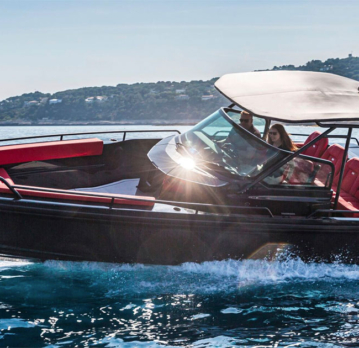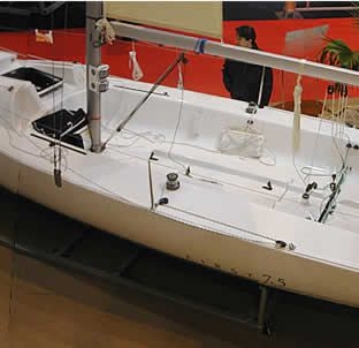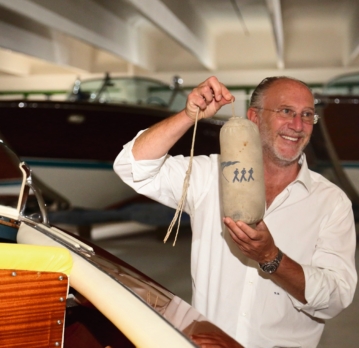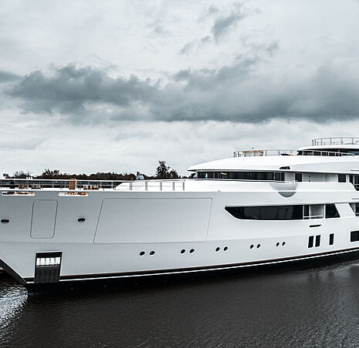Next Saturday, August 3, starts the famous regatta Fastnet Race. We offer to your attention a condensed version of material Andrei Kirsanov about this amazing race, which is published in the August issue of magazine Yacht Russia.


Race the Rolex Fastnet Race, so the sound of her full name, is one of the most complex marine offshore regattas. Every two years in the port of Cowes on the Isle of Wight, where starts the regatta, attracts sailors from around the world. The distance of 608 nautical miles from rounding the Fastnet rock, known as the “Teardrop of Ireland”, which was the last piece of land, which saw Irish immigrants fleeing to America, replete with dangers, including the current, huge waves of the open sea and strong wind.
A little background
In the first half of the twentieth century from a “long” marine regattas, there were only founded in 1904 by the Rudder magazine editor Thomas Fleming the Day race Newport-Bermuda Race and leading his descent from the 1860 race Dublin Bay Cork Harbour. Another was organized in 1906, a race from California across the Pacific to Hawaii, but she has not received proper attention from the European sailors, as they were in warm waters, far from true, according to the Old world ocean – the Atlantic. Finally, at the turn of the century there were several transatlantic races in which competed a huge yacht with professional teams.
In General yachting community of the South coast of the UK and the Isle of Wight initially with great skepticism attitude to the conduct of offshore races in the cold waters of the Eastern Atlantic. It was believed that modern yachts available for these races are not suitable.
Of course, there were those who thought differently, among them George Martin, who since 1905 has been a member of the Royal Cruising Club (RCC). His word had weight, because Martin was twice, in 1907 and 1908, was awarded the main prize RCC challenge Cup The Challenge Cup. The Cup was awarded for his voyage on the 35-ton cutter havelina the Chance in 1903: the first – from the shores of Devon to Gibraltar and back; the second, around Denmark, during which the crew visited ports in Norway, Sweden and Germany.
So, according to George Martin, the Royal Cruising Club simply must be the organizer of a truly ocean racing. However, his ideas met tough resistance even from teammates. Against the organization of a new offshore regatta spoke 129 member of the club, only 49 were for.
Disappointed with the vote, George Martin left the ranks of the Royal Cruising Club, but, of course, not sailing. By 1923, he said goodbye to the Chance for a new cutter Jolie Brise. Built in 1913, this elegant yacht was one of the fastest pilot bots in the channel port of Le Havre, but was “dismissed from service” under the pressure of the steam counterparts. This ship was destined to play a key role in the birth of the Fastnet Race.
From ideas George Martin was not going to give up, gradually recruiting the supporters of the 600-mile ocean race starts in the Solent and the finish in Plymouth. And then he had a very active ally…
In 1922-1924 the Englishman Weston martir took part in the Bermuda Race. Despite the fact that a navigational error in the regatta of 1924 left the crew of the Martyr in last place, inspired by the passion and by the spirit of the competition, he was full of enthusiasm and optimism, and on returning home began to throw the yachting magazines in the UK to hold a similar race in the waters of the North Atlantic. Martir wrote: “This is, without question, the most beautiful sport, which can only be to the gentleman involved, because in order to play this game, you must have the hallmarks of a true sportsman: skill, courage and endurance.”
The beginning of the legend
Offer Weston Martyr warmly supported British sailing magazines, including Yachting Monthly and Yachting World… To the beginning of 1925, the movement in favor of a new ocean regatta got underway, and it could not be stopped. It was then
George Martin, Weston martir and editor of Yachting Monthly Madeleine Heckstall Smith formed the Committee for the organisation of the race, who first decided on the route: the Solent – Fastnet rock – Plymouth. The seventh of March 1925 in the newspaper The Morning Post appeared a notice that “the regatta will be held under the flag of the Royal Western Yacht Club”.
During the month the race came four of the crew, and the first of July, the list of potential participants increased to 14 pennants, including one team from the United States. And still 15 August, has started only seven teams, but the Irishman Harry Donegan, who played on the 18-ton yacht, Gull, was the only one who is slightly diluted British participants. It is, however, to note that at the time of the British yachting establishment (not just yachting) considered the question of establishing an independent Irish state only “temporary error.” Nevertheless, the regatta, in fact, has become an international…
The first Fastnet race was a classic from the point of view of the results: a fast boat made a swift dash and successfully reached the finish line in Plymouth, while the slower sailboats are faced with gusty winds and a rough sea. In the end, two boats withdrew, and one failed to finish in the time allotted – judges-timekeepers had already gone home.
Yacht Harry Donegan had more modern lines compared to boats of other participants of the regatta, and for some time headed Gull fleet. She first passed the Isles of Scilly, but then corrupted by the Mars file, the speed fell and seized the lead of Jolie Brise, George Martin.
On the way back to Plymouth when viewmem southwest wind 20 Aug Donegan wrote in his logbook: “Folding table in the wardroom doing everything to kill me. I got hit in the chest and chin, while the hefty box was trying to cut off one or both my feet.”
But all that was nothing compared to the main task – to catch up with Jolie Brise. We had chances, but mistakes by team Gull in conditions of poor visibility, took a boat to the North of land’s End, a rocky promontory on the South-West of the UK.
The winner of the first Fastnet was the crew of the Jolie Brise with a time of 6 days 14 hours and 45 minutes. The second was a 38-foot cutter Fulmar, Gull came third.
Looking ahead, we say that Jolie Brise has won the Fastnet Race in 1929 and 1930 and that the boat to this day afloat, taking part in regattas, and in 2000 won the overall standings in the regatta Tall Ships Race.
New club
It was during the first Fastnet race George Martin announced the creation of the Ocean Racing Club, as well as the holding which came sailors for the regatta next year. Indeed, the race has shown itself to be an exciting contest, and besides, it was possible to engage a small crew or even alone.
In his message to Weston to Martin on November 12, 1925, Harry Donegan admitted: “I love this race and glad to get your letter, which breathes the sea. And let me just say that if my team has impressed you, it is unlikely that more than this contest is for us. I’m impressed with how high class sailors who share ideas with Ocean Cruising Club, which means that the regatta is the future”.
Note that, despite the undoubted success of the regatta, sailors were still opposed to the race and all the supporters became more and more. Among these enthusiasts was a man who decided to build a boat specifically aimed at this regatta. Scot Norman Baxendale ordered William III Five to build a cutter with a Bermuda service, which will comply with the new rules Ocean Racing Club – 70 feet long, 50 feet at the waterline. On the drawing boards, then on the stocks began. The new boat was given the name of Hallowe’en.
The second time
Of course, there were those who, once having taken part in the Fastnet race, was not intended again to engage in this adventure, but there were also those who believed it is obligatory for him. Among these “hard-nosed” was Harry Donegan, who declared their participation in the regatta of 1926.
The second Fastnet Race was attended by eight boats. Despite the strong, comfortable wind, Hallowe’en was at the finish line first with a lead of just 10 hours, while setting a record for this race, which was held until 1939. By the time the organizers of the race for participation were made larger sailboats, so this was expected. New record time belonged to the 88-foot yiolou Nordwind, which was ruled by a German crew, and it should be noted that the German sailors not endeared himself to the regatta organizers to its odd appearance and behavior: they were dressed in military uniform, and at the ceremony, raised his hand in a Nazi salute. If we proceed from the size of the boat, until 1971, no one could break the record of Hallowe’en, yet the water was not launched yacht Ted Turner with a Patriotic American Eagle.
Leaders and participants
Fastnet conduct each year, as it was supposed, was too much for organizers, and in 1931 the regatta has been held every two years, eventually becoming a sort of minimum qualification for boaters of krugosvetku.
If you look at the first 15 races, from 1925 to 1953, the statistics is relentless: the British firmly holds her championship – 10 wins. Four times were won by the Americans (it is noteworthy that three of those wins were won on the yacht, designed by the Bureau of Sparkman & Stephens). Only one win during this period went to the Dutch sailors, speaking in 1937, the sailing ship Zeearend.
To 1970-m to years the popularity of the regatta has become incredible after it became involved such giants as Francis Chichester, Robin Knox-Johnston and even… the leader of the conservative party Edward Heath, who in the race in 1969 aboard the yacht Morning Cloud was able to take seventh place in his class.
In 1973 was introduced by the International measurement rules (International Offshore Rule), and in the same year, the teams and boats received permission to sponsorship.
Tragedy 1979
Every race may come dark days. In August 1979, pages of Newspapers and magazines, even far from the yacht theme, were full of gloomy headlines: “Race with death”, “death toll could be more, Only if the element is to blame?”. Reports from the scene, in an interview with the officials discussed the circumstances and causes of the tragedy during the race the Fastnet.
On Saturday 11 August, with a 3-4-point westerly winds in the port of Cowes has launched a fleet of 306 boats. In intervals of 10 min to the distance of the left boats from seven different classes. Saturday and Sunday the fleet advanced along the southern coast of the UK with weak winds from West and poor visibility. There were no signs of further deterioration in the weather. When in the night of Monday the weather station gave the forecast that promised wind up to 5-6 points, the majority of participants of a regatta that was even more pleased.
Almost simultaneously with the start of the Cowes regatta is far from over coast of Canada – born cyclone, which began its movement across the North Atlantic at about 1000 miles per day. Approaching the coast of Ireland, the warm air mass came from the Western coast of the Atlantic, collided with a cold front, coming from Iceland. For a short period of time the pressure in the center of the cyclone dropped to 979 millibars, the trajectory of the cyclone sharply deviated from the route outlined by forecasters, to the North, and the cyclone passed over the center of the Irish sea between the archipelago of Scilly and the rock of Fastnet. Needless to say that by the beginning of the storm, here was the bulk of the yacht…
The duty of rescue station of the Royal Navy in Culdrose – on the Peninsula of Cornwall, whiling away his watch, 1:40 overheard in the dynamics sounded weakened by the distance and interference disturbing voice: “Mayday!” The crew of the yacht, which had broken a wheel, had requested urgent assistance: the waves broke hatch cover.
Soon the distress signals began to arrive one after the other, calls for help filled the air. Mostly they were served with a yacht that has not reached the Fastnet rocks, and were situated to the Nord-West of Scilly at a distance of from 15 to 100 miles from the lizard point.
This is the result: sixty-nine yachts not finished, twenty-four were left by the crew of five sank, killing 15 sailors. Drama Fastnet 1979 was the largest tragedy in the history of modern sailing.
People
The struggle between two Maritime Nations, the British and French, was fully apparent in the waters of the Irish sea.
The first victory of France in the Fastnet brought in 1967 by none other than Eric Tabarli in Duick III, a 17-metre aluminium yacht, designed by him. In the same year he won on the boat for the Sydney to Hobart.
Then fortune again turned away from the French, while in 1999, Whirlpool-Europe 2 under the control of Catherine of Sabow was not the first at the finish. In 2005, the Fastnet winner on corrected time was the French crew of Jean-Yves Chateau Iromiguy on.
In 2013, once again triumphed the French, they won and the following season in 2015 and 2017.
In 2001, the official sponsor of the Fastnet was the Swiss watch company Rolex. The sponsor’s name was added to the official name of the regatta, it was called the Rolex Fastnet Race.
In 2013, the list of applications to participate Fastnet was filled for 24 hours from the time of its opening. (In recent years, in order to apply, you need to meet in five minutes.) In that year the list of exhibitors was a record number of 12 teams from Russia. In General, for nearly a century the history of the race it is not just attended by Russian crews. So, in 1997 and 1999, it was the catamaran “Ivan” (and won in its class). Another constant participant of the all – Russian yacht “Anna”. In the race several times participated and the team of the Russian club offshore racing SeaVentus.
In General, in the entire history of the famous race the British had won it 17 times, while the French managed to come first six times, but emerging in the last three races, the trend promises in 2019 to add the regatta of fire. And yet it remains anyone’s guess who will be the strongest this year again the French, British… and maybe someone else?
fastnetlegendary













What do you think?